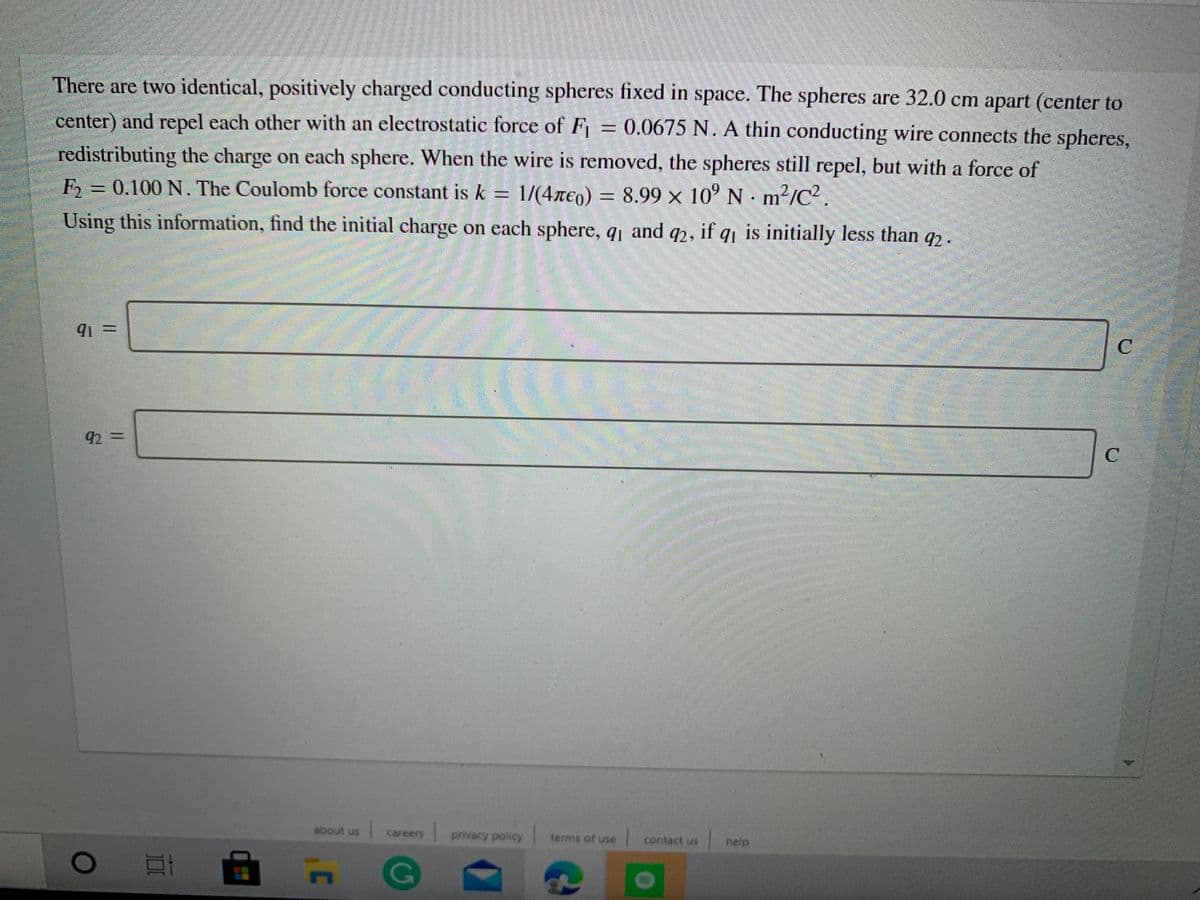There are two identical, positively charged conducting spheres fixed in space. The spheres are 32.0 cm apart (center to center) and repel each other with an electrostatic force of Fi = 0.0675 N. A thin conducting wire connects the spheres, redistributing the charge on each sphere. When the wire is removed, the spheres still repel, but with a force of F = 0.100 N. The Coulomb force constant is k = 1/(4xe0) = 8.99 x 10° N · m²/C² . Using this information, find the initial charge on each sphere, q and q2, if q, is initially less than q2 . 91 = 92 =
There are two identical, positively charged conducting spheres fixed in space. The spheres are 32.0 cm apart (center to center) and repel each other with an electrostatic force of Fi = 0.0675 N. A thin conducting wire connects the spheres, redistributing the charge on each sphere. When the wire is removed, the spheres still repel, but with a force of F = 0.100 N. The Coulomb force constant is k = 1/(4xe0) = 8.99 x 10° N · m²/C² . Using this information, find the initial charge on each sphere, q and q2, if q, is initially less than q2 . 91 = 92 =
Physics for Scientists and Engineers with Modern Physics
10th Edition
ISBN:9781337553292
Author:Raymond A. Serway, John W. Jewett
Publisher:Raymond A. Serway, John W. Jewett
Chapter25: Capacitance And Dielectrics
Section: Chapter Questions
Problem 30P: An infinite line of positive charge lies along the y axis, with charge density = 2.00 C/m. A dipole...
Related questions
Question
100%

Transcribed Image Text:There are two identical, positively charged conducting spheres fixed in space. The spheres are 32.0 cm apart (center to
center) and repel each other with an electrostatic force of F = 0.0675 N. A thin conducting wire connects the spheres,
redistributing the charge on each sphere. When the wire is removed, the spheres still repel, but with a force of
F = 0.100 N. The Coulomb force constant is k = 1/(4TEO)
= 8.99 × 10° N m²/C2.
Using this information, find the initial charge on each sphere, q and
q2, if q1 is initially less than q2.
92=D
about us
careers
privacy policy
terms of use
contact us
help
Expert Solution
Step 1
For the initial arrangement, the formula for the electrostatic force between the charged system is:

Substitute the known values and solve as:

Trending now
This is a popular solution!
Step by step
Solved in 6 steps with 9 images

Knowledge Booster
Learn more about
Need a deep-dive on the concept behind this application? Look no further. Learn more about this topic, physics and related others by exploring similar questions and additional content below.Recommended textbooks for you

Physics for Scientists and Engineers with Modern …
Physics
ISBN:
9781337553292
Author:
Raymond A. Serway, John W. Jewett
Publisher:
Cengage Learning

Physics for Scientists and Engineers
Physics
ISBN:
9781337553278
Author:
Raymond A. Serway, John W. Jewett
Publisher:
Cengage Learning

Principles of Physics: A Calculus-Based Text
Physics
ISBN:
9781133104261
Author:
Raymond A. Serway, John W. Jewett
Publisher:
Cengage Learning

Physics for Scientists and Engineers with Modern …
Physics
ISBN:
9781337553292
Author:
Raymond A. Serway, John W. Jewett
Publisher:
Cengage Learning

Physics for Scientists and Engineers
Physics
ISBN:
9781337553278
Author:
Raymond A. Serway, John W. Jewett
Publisher:
Cengage Learning

Principles of Physics: A Calculus-Based Text
Physics
ISBN:
9781133104261
Author:
Raymond A. Serway, John W. Jewett
Publisher:
Cengage Learning

Physics for Scientists and Engineers: Foundations…
Physics
ISBN:
9781133939146
Author:
Katz, Debora M.
Publisher:
Cengage Learning

Physics for Scientists and Engineers, Technology …
Physics
ISBN:
9781305116399
Author:
Raymond A. Serway, John W. Jewett
Publisher:
Cengage Learning

College Physics
Physics
ISBN:
9781285737027
Author:
Raymond A. Serway, Chris Vuille
Publisher:
Cengage Learning